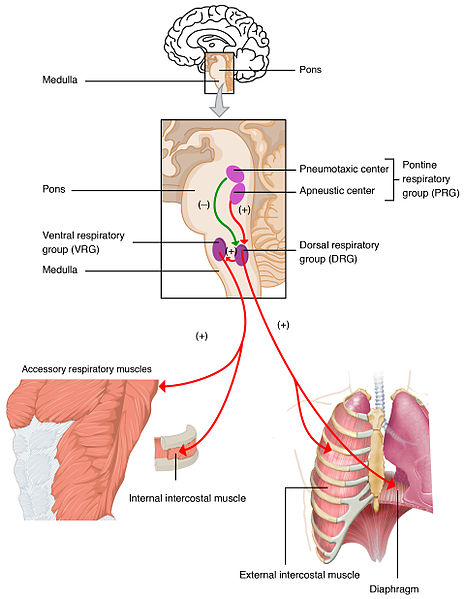[1]
Miyazaki M,Arata A,Tanaka I,Ezure K, Activity of rat pump neurons is modulated with central respiratory rhythm. Neuroscience letters. 1998 Jun 12;
[PubMed PMID: 9672389]
Level 3 (low-level) evidence
[2]
WIDDICOMBE JG. Respiratory reflexes in man and other mammalian species. Clinical science. 1961 Oct:21():163-70
[PubMed PMID: 14006725]
[3]
Grunstein MM, Younes M, Milic-Emili J. Control of tidal volume and respiratory frequency in anesthetized cats. Journal of applied physiology. 1973 Oct:35(4):463-76
[PubMed PMID: 4743002]
[4]
Clark FJ, von Euler C. On the regulation of depth and rate of breathing. The Journal of physiology. 1972 Apr:222(2):267-95
[PubMed PMID: 5033464]
[5]
BuSha BF, Judd BG, Manning HL, Simon PM, Searle BC, Daubenspeck JA, Leiter JC. Identification of respiratory vagal feedback in awake normal subjects using pseudorandom unloading. Journal of applied physiology (Bethesda, Md. : 1985). 2001 Jun:90(6):2330-40
[PubMed PMID: 11356800]
[6]
BuSha BF, Stella MH, Manning HL, Leiter JC. Termination of inspiration by phase-dependent respiratory vagal feedback in awake normal humans. Journal of applied physiology (Bethesda, Md. : 1985). 2002 Sep:93(3):903-10
[PubMed PMID: 12183484]
[7]
Hamilton RD,Winning AJ,Horner RL,Guz A, The effect of lung inflation on breathing in man during wakefulness and sleep. Respiration physiology. 1988 Aug;
[PubMed PMID: 3420318]
[8]
Bradley GW, von Euler C, Marttila I, Roos B. Steady state effects of CO-2 and temperature on the relationship between lung volume and inspiratory duration (Hering-Breuer threshold curve). Acta physiologica Scandinavica. 1974 Nov:92(3):351-63
[PubMed PMID: 4454993]
[9]
Trippenbach T. Pulmonary reflexes and control of breathing during development. Biology of the neonate. 1994:65(3-4):205-10
[PubMed PMID: 8038284]
[10]
CROSS KW, KLAUS M, TOOLEY WH, WEISSER K. The response of the new-born baby to inflation of the lungs. The Journal of physiology. 1960 Jun:151(3):551-65
[PubMed PMID: 13813016]
[11]
Rabbette PS,Costeloe KL,Stocks J, Persistence of the Hering-Breuer reflex beyond the neonatal period. Journal of applied physiology (Bethesda, Md. : 1985). 1991 Aug;
[PubMed PMID: 1938718]
[12]
Rabbette PS, Fletcher ME, Dezateux CA, Soriano-Brucher H, Stocks J. Hering-Breuer reflex and respiratory system compliance in the first year of life: a longitudinal study. Journal of applied physiology (Bethesda, Md. : 1985). 1994 Feb:76(2):650-6
[PubMed PMID: 8175574]
[13]
Bechbache RR, Chow HH, Duffin J, Orsini EC. The effects of hypercapnia, hypoxia, exercise and anxiety on the pattern of breathing in man. The Journal of physiology. 1979 Aug:293():285-300
[PubMed PMID: 501598]
[14]
Cunningham DJ, Gardner WN. A quantitative description of the pattern of breathing during steady-state CO2 inhalation in man, with special emphasis on expiration. The Journal of physiology. 1977 Nov:272(3):613-32
[PubMed PMID: 592205]
[15]
Duffin J, Mohan RM, Vasiliou P, Stephenson R, Mahamed S. A model of the chemoreflex control of breathing in humans: model parameters measurement. Respiration physiology. 2000 Mar:120(1):13-26
[PubMed PMID: 10786641]
[16]
Dutschmann M, Bautista TG, Mörschel M, Dick TE. Learning to breathe: habituation of Hering-Breuer inflation reflex emerges with postnatal brainstem maturation. Respiratory physiology & neurobiology. 2014 May 1:195():44-9. doi: 10.1016/j.resp.2014.02.009. Epub 2014 Feb 22
[PubMed PMID: 24566392]
[17]
Hand IL, Noble L, Wilks M, Towler E, Kim M, Yoon JJ. Hering-Breuer reflex and sleep state in the preterm infant. Pediatric pulmonology. 2004 Jan:37(1):61-4
[PubMed PMID: 14679491]
[18]
Berger AJ, Dick TE. Connectivity of slowly adapting pulmonary stretch receptors with dorsal medullary respiratory neurons. Journal of neurophysiology. 1987 Dec:58(6):1259-74
[PubMed PMID: 3437333]
[19]
Bonham AC, McCrimmon DR. Neurones in a discrete region of the nucleus tractus solitarius are required for the Breuer-Hering reflex in rat. The Journal of physiology. 1990 Aug:427():261-80
[PubMed PMID: 2213599]
[20]
Bonham AC, Coles SK, McCrimmon DR. Pulmonary stretch receptor afferents activate excitatory amino acid receptors in the nucleus tractus solitarii in rats. The Journal of physiology. 1993 May:464():725-45
[PubMed PMID: 8229827]
[21]
Miyazaki M, Tanaka I, Ezure K. Excitatory and inhibitory synaptic inputs shape the discharge pattern of pump neurons of the nucleus tractus solitarii in the rat. Experimental brain research. 1999 Nov:129(2):191-200
[PubMed PMID: 10591893]
[22]
Berger AJ. Dorsal respiratory group neurons in the medulla of cat: spinal projections, responses to lung inflation and superior laryngeal nerve stimulation. Brain research. 1977 Oct 28:135(2):231-54
[PubMed PMID: 922474]
[23]
Ezure K, Tanaka I. GABA, in some cases together with glycine, is used as the inhibitory transmitter by pump cells in the Hering-Breuer reflex pathway of the rat. Neuroscience. 2004:127(2):409-17
[PubMed PMID: 15262331]
Level 3 (low-level) evidence
[24]
von Euler C. The contribution of sensory inputs to the pattern generation of breathing. Canadian journal of physiology and pharmacology. 1981 Jul:59(7):700-6
[PubMed PMID: 6274493]
[25]
Bianchi AL, Denavit-Saubié M, Champagnat J. Central control of breathing in mammals: neuronal circuitry, membrane properties, and neurotransmitters. Physiological reviews. 1995 Jan:75(1):1-45
[PubMed PMID: 7831394]
[26]
Kubin L, Alheid GF, Zuperku EJ, McCrimmon DR. Central pathways of pulmonary and lower airway vagal afferents. Journal of applied physiology (Bethesda, Md. : 1985). 2006 Aug:101(2):618-27
[PubMed PMID: 16645192]
[27]
Wang J, Wang Y, Feng J, Chen BY, Cao J. Complex sleep apnea syndrome. Patient preference and adherence. 2013:7():633-41. doi: 10.2147/PPA.S46626. Epub 2013 Jul 3
[PubMed PMID: 23861580]
[28]
Siniaia MS, Young DL, Poon CS. Habituation and desensitization of the Hering-Breuer reflex in rat. The Journal of physiology. 2000 Mar 1:523 Pt 2(Pt 2):479-91
[PubMed PMID: 10699090]
[29]
Dhingra RR, Zhu Y, Jacono FJ, Katz DM, Galán RF, Dick TE. Decreased Hering-Breuer input-output entrainment in a mouse model of Rett syndrome. Frontiers in neural circuits. 2013:7():42. doi: 10.3389/fncir.2013.00042. Epub 2013 Apr 3
[PubMed PMID: 23565077]
[30]
Moore RL. A STUDY OF THE HERING-BREUER REFLEX. The Journal of experimental medicine. 1927 Oct 31:46(5):819-37
[PubMed PMID: 19869374]

